Introduction
Education is at a turning point, shaped by two big trends—the growing skills gap and the rapid rise of artificial intelligence (AI). As industries evolve, employers are worried about the shortage of job-ready graduates. As workforce demands continue to evolve, the skills students acquire in school may not always match the realities of today’s job market. That’s why we are offering GoReact Advanced, a package where you can leverage AI tools to help improve education and help reduce the skills gap.
According to the National Skills Coalition, 92% of jobs now require digital skills, but nearly one-third of workers don’t have them. And it’s not just technical skills that are falling short—employers are also looking for soft skills like critical thinking, teamwork, and problem-solving, which are often underdeveloped in new hires.
At the same time, AI is transforming industries and reshaping how we work and learn. For educators, AI in higher education brings both new challenges and exciting opportunities as they work to prepare students for a rapidly evolving job market that may look very different than today’s.
These two forces—the growing skills gap and the rise of AI—are putting higher education under pressure. The old ways of teaching and assessing just aren’t enough anymore. Graduates need to be ready for jobs that don’t even exist yet, equipped with adaptable skills that can transfer across industries and technologies. This shift calls for a fresh approach to how skills are developed, assessed, and validated, with a focus on real-world applications and continuous feedback to keep students on track for success.
Bridging the Gap Between Education and Workforce
The skills gap—the disconnect between the skills employers require and those job seekers possess—continues to widen across industries, driven by rapid advances in technology and the digitization of the workforce. Many jobs today demand higher levels of digital literacy, yet a significant portion of the U.S. workforce lacks these essential skills. This gap has far-reaching implications, not just for individuals but also for industries that are struggling to find qualified candidates.
While technical skills in areas like data analysis, software development, and cloud computing are crucial, employers are placing increasing emphasis on transferable soft skills. Skills like communication, collaboration, critical thinking, and adaptability are becoming indispensable across all sectors. A Deloitte study highlights that 77% of employers now value these soft skills just as highly as technical abilities, emphasizing their importance in today’s evolving job market.
Data from NACE reinforces this trend, with problem-solving, critical thinking, and teamwork consistently ranking as top attributes employers seek in new graduates. Unfortunately, many recent hires lack proficiency in these areas, leaving a clear gap between the capabilities employers need and the skillsets that students develop during their education.
Looking ahead, by 2025, in-demand skills like complex problem-solving, active learning, and resilience will be among the most sought-after, yet many students are not being trained in these areas. This growing gap could leave a substantial portion of the workforce underprepared for the jobs of the future, and it’s a challenge that higher education must address.
To close this gap, educational institutions need to rethink how they prepare students for the workforce. A stronger emphasis on skill practice, continuous feedback, and hands-on learning is essential to ensure that students are not only gaining theoretical knowledge but also developing the practical and soft skills required to thrive in an ever-evolving job market.
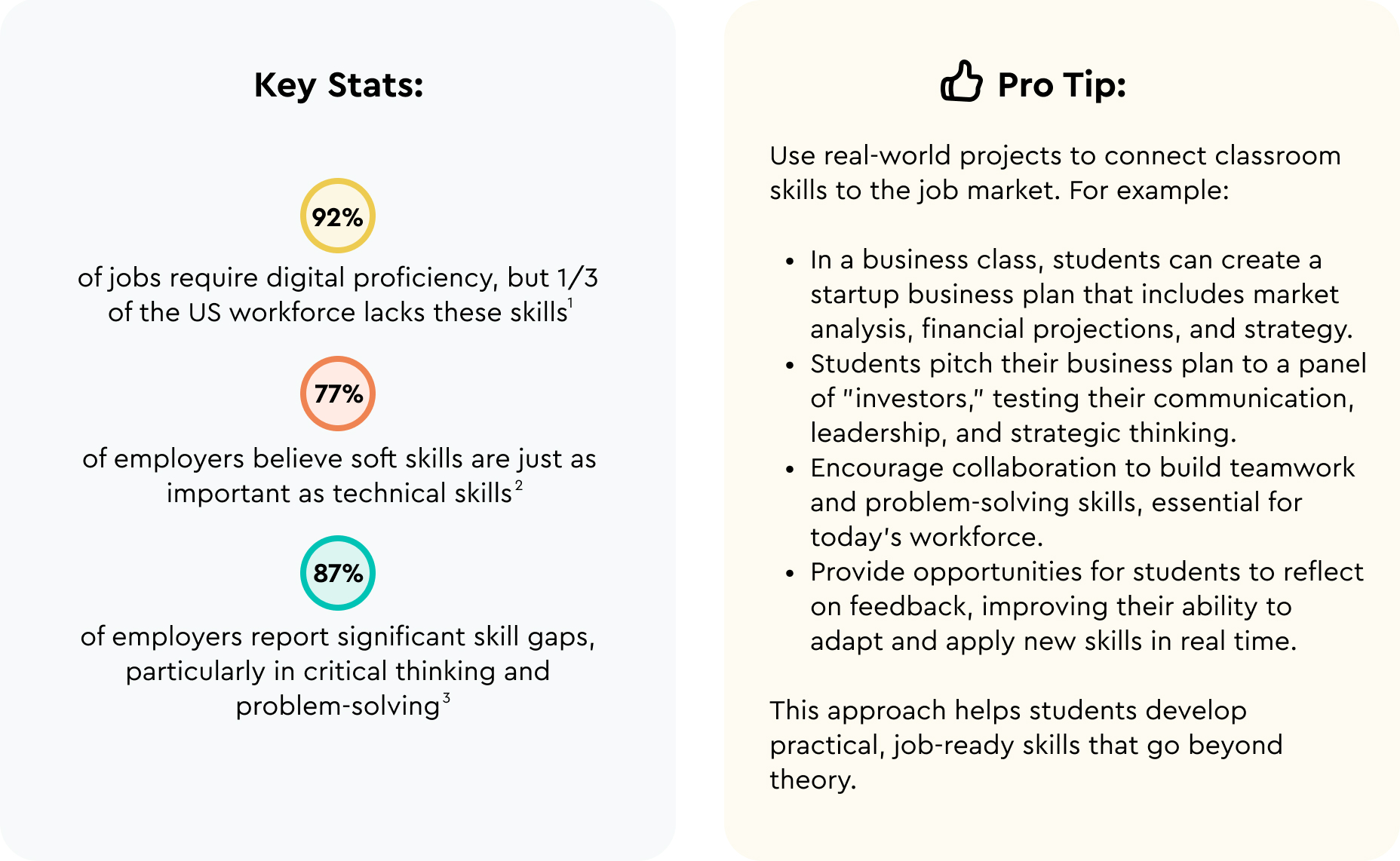
AI in Higher Education: Benefits & Challenges
Artificial intelligence (AI) is rapidly reshaping industries worldwide, and education is no exception. As AI technologies advance, they are transforming how students learn, how teachers teach, and how skills are developed and assessed. AI is not just automating routine tasks; it’s creating more personalized learning experiences, enabling more efficient feedback, and fostering the development of critical skills for the modern workforce.
Students are at the forefront of AI adoption, with a majority already using AI tools. A recent BestColleges survey revealed that 72% of college students have used AI tools for learning, ranging from AI-based tutoring platforms to writing assistants.
With AI becoming more integrated into education, institutions must adapt their curricula and teaching methods to incorporate these technologies while ensuring that students are equipped with both the technical and human skills required to thrive in an AI-enhanced world.
However, with these benefits come important ethical considerations and challenges that cannot be overlooked. The rapid adoption of AI raises concerns around data privacy and the security of student information, especially as educational institutions increasingly rely on AI-driven platforms. Evolving policies are critical in ensuring that sensitive data is handled with the utmost care.

Another challenge is the potential for cheating, as AI-generated content becomes harder to distinguish from student work. This makes it necessary for educators to stay ahead of evolving AI capabilities and develop new methods of assessment that discourage dishonesty and promote genuine skill development.
Finally, there are concerns about the role of humans in an AI-driven world, particularly in education. As AI takes on more tasks, educators and policymakers must ensure that AI serves as a tool to augment human roles, not replace them. It’s crucial to strike a balance between leveraging AI’s capabilities while preserving the irreplaceable value of human interaction in teaching, mentoring, and skill-building.
By addressing these ethical challenges and integrating AI responsibly, educators can help students develop both the technical proficiency and adaptive, human-centered skills needed to thrive in an AI-enhanced workforce. With the right safeguards and innovative approaches, AI has the potential to significantly enrich the educational experience and better prepare students for the future.
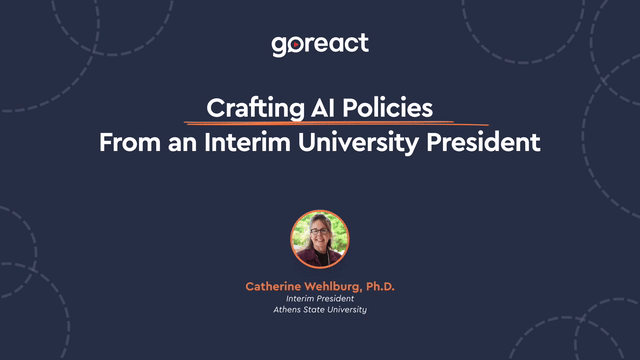
The Importance of Student Skill Assessment
With AI advancing how students learn and industries evolving rapidly, the need for accurate and meaningful student skill assessment has become more urgent than ever. To prepare students for the workforce, institutions must ensure that they are not only teaching the right skills but also assessing them in ways that reflect real-world challenges.
Why Skills Matter
In today’s evolving job market, skills are the foundation for success, whether students are preparing for professional careers, trade-specific roles, or hands-on vocations. Whether it’s technical expertise like welding or coding, or soft skills such as problem-solving and teamwork, employers across sectors prioritize candidates who can demonstrate their knowledge along with strong skills that enable students to enter the workforce immediately, while still being adaptable to changes within their field. Skill mastery is essential in ensuring that graduates, regardless of their path, are ready to meet the demands of their chosen careers.
The Full Spectrum of Skills
When we talk about skills, it’s essential to think broadly. Technical skills are role-specific, involving the hard knowledge required for a particular job, such as data analysis, engineering, or healthcare procedures. On the other hand, soft skills, like collaboration, communication, and problem-solving, cut across industries and are often what employers cite as the most valuable. Both types of skills are critical to job readiness, and developing these diverse abilities ensures students can handle the complexities of today’s workforce.
While it’s clear that both technical and soft skills are critical to success, the challenge lies in how these skills are evaluated. Traditional assessment methods, which have long been the standard in education, often fail to capture the depth and breadth of skills that students need to excel in today’s workforce. To truly prepare students for their careers, we must look beyond traditional exams and explore more effective ways to measure their abilities.

Overcoming the Limitations of Traditional Testing
Traditional testing methods, such as written exams and multiple-choice questions, often fall short when it comes to evaluating the skills students truly need in the workforce. These types of assessments typically focus on measuring knowledge, but they miss out on evaluating a learner’s ability to apply that knowledge in real-world settings.
Key limitations of traditional testing include:
- Lack of Validation: Exams don’t assess whether students can actually perform tasks or solve problems they’ll encounter on the job.
- No Opportunity for Practice or Reflection: One-time tests don’t promote the ongoing practice, feedback, and self-reflection necessary for true skill mastery.
- Disconnect from the Real World: Traditional assessments rarely mimic the complexities and unpredictability of real-life work environments, leaving graduates unprepared for the challenges they’ll face.
These shortcomings create a gap between what students learn in the classroom and the skills they need to thrive in their careers. That’s where authentic assessments come in, offering a more effective way to evaluate both soft skills and technical skills by focusing on practical application.
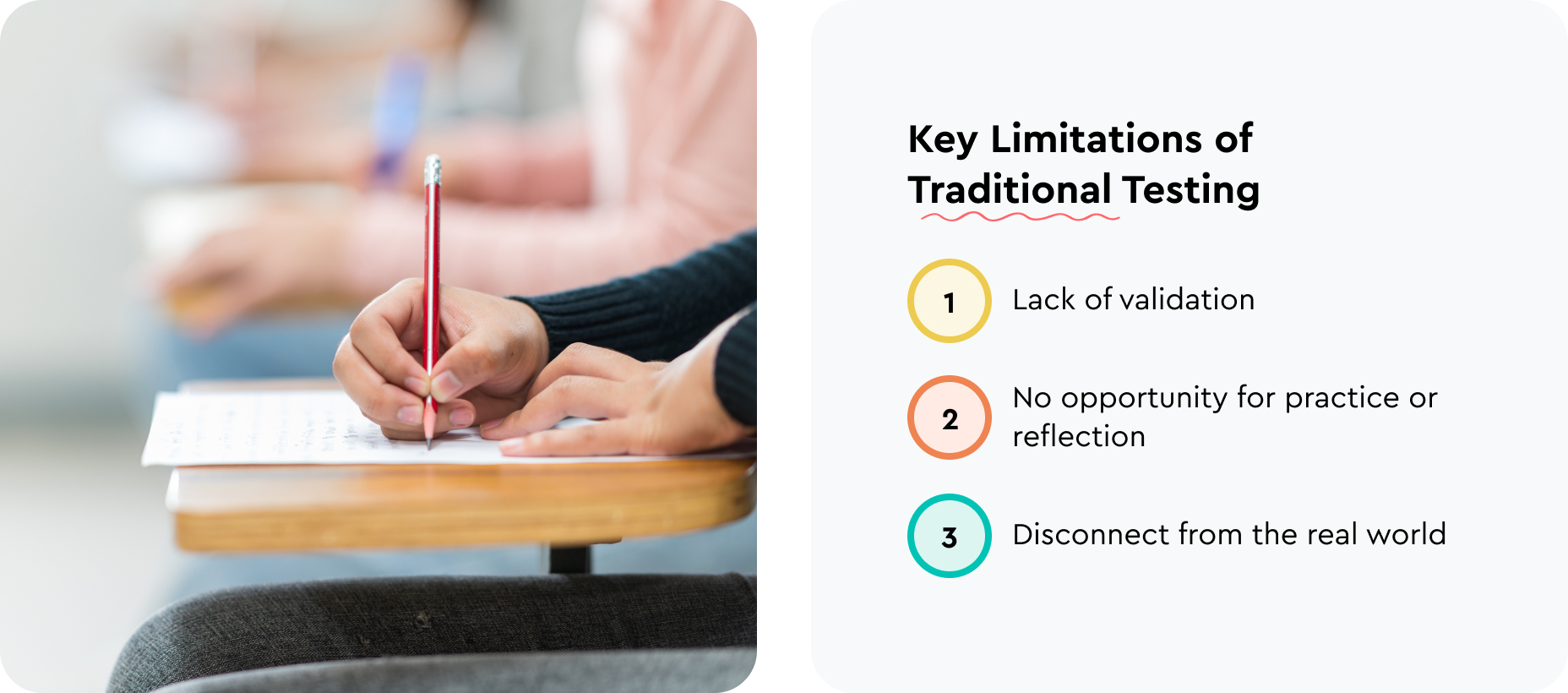
The Power of Authentic Assessments
Authentic assessment bridges the gap by asking students to demonstrate their skills in realistic, job-like scenarios. These types of assessments are more effective than traditional exams because they reflect the actual challenges students will face in their professions.
Authentic assessments are designed to:
- Validate Skills in Action: They test whether students can perform tasks in real-world or simulated settings, ensuring they’re truly prepared for the workforce.
- Encourage Deeper Learning: By mirroring real-world challenges, these assessments engage students in problem-solving and critical thinking, pushing them beyond memorization.
- Promote Practice and Reflection: Authentic assessments often involve multiple opportunities for practice and feedback, which are critical for continuous improvement.
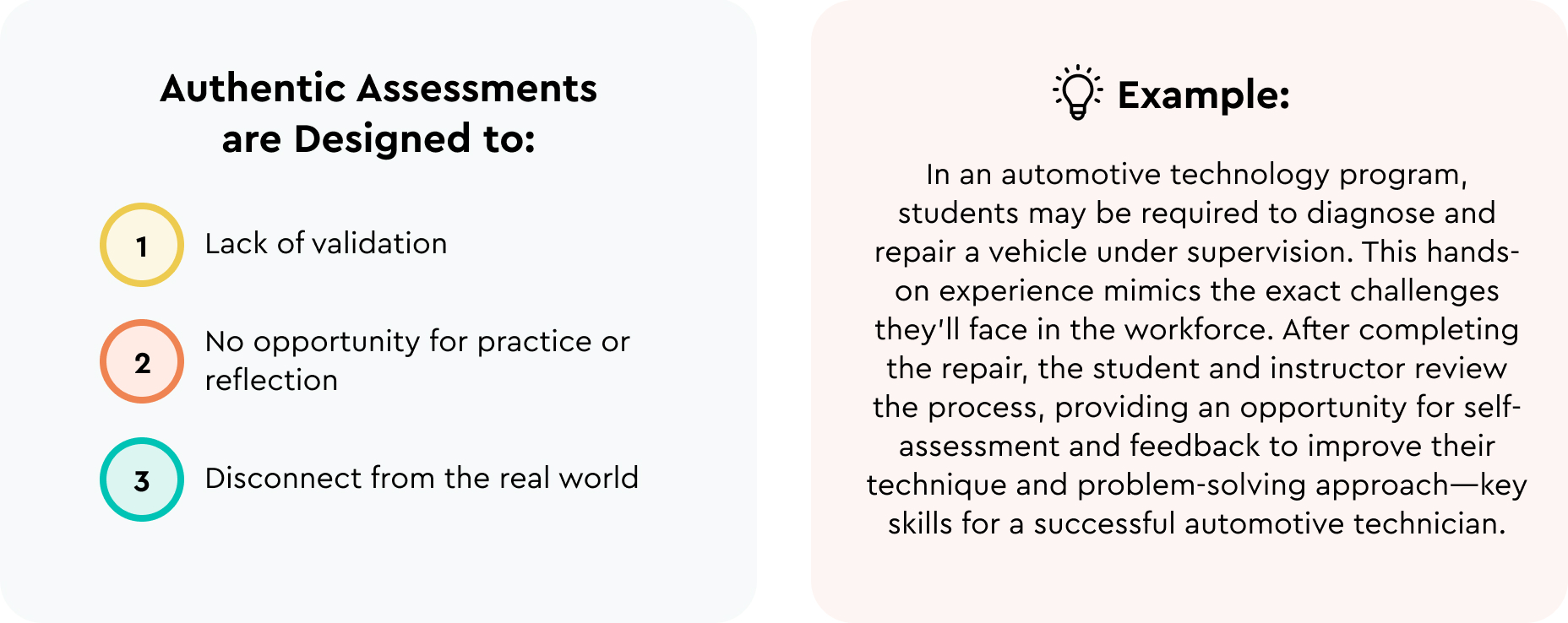

Practice + Reflect + Assess + Feedback = Skill Mastery
At the core of skill development is the cycle of learning, which includes practice, reflection, assessment, and feedback. Authentic assessments play a key role in this cycle, as they create opportunities for students to engage with real-world tasks, evaluate their own performance, and refine their abilities over time.
- Practice: Students engage in practical tasks that closely mimic their future job responsibilities.
- Reflection: After performing tasks, students critically analyze their performance, identifying areas for improvement.
- Assessment: Authentic assessments measure whether students can apply their knowledge and skills effectively in real-world contexts.
- Feedback: Timely, specific feedback from instructors or peers helps students adjust and refine their skills, ensuring ongoing development.

From “Knowing” to “Doing”
As the workforce becomes more skills-driven, it’s not enough for students to demonstrate what they know—employers want to see that they can do the job. This shift emphasizes the importance of real-world skill demonstrations over theoretical knowledge. Evaluating whether learners can perform tasks, solve problems, and apply their skills in practical settings has become the gold standard for preparing them for their future careers.

Internships, apprenticeships, and other hands-on experiences help bridge the gap between classroom learning and real-world application. These experiences allow students to practice their skills in professional settings, giving them the opportunity to gain firsthand experience while refining their abilities. However, to fully support this transition from learning to doing, educators need robust tools to assess whether students are truly ready for the workforce.
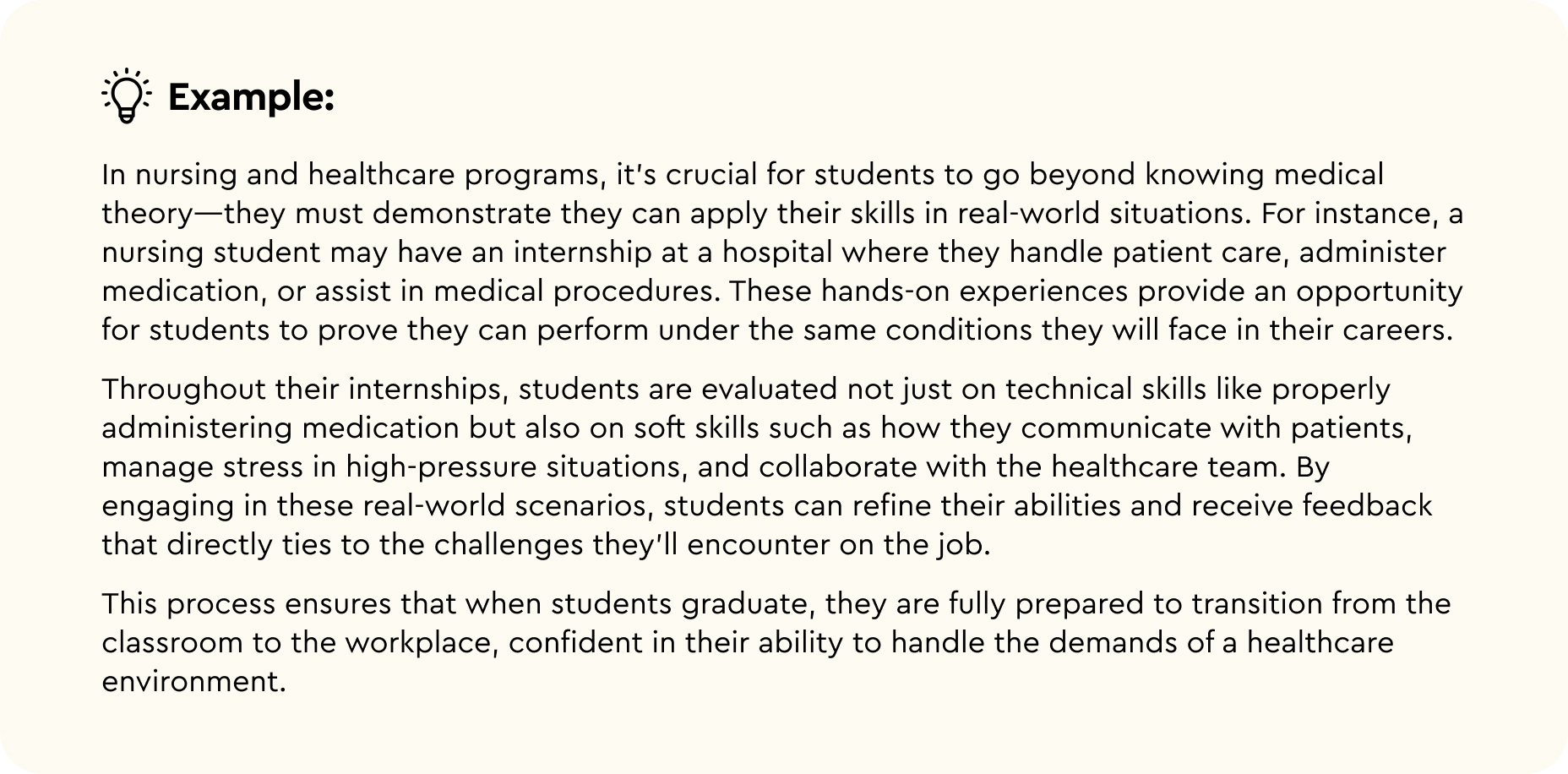
Best Practices for Effective Student Skill Assessments
- Design Real-World, Job-Like Tasks: Ensure assessments are based on tasks that students will encounter in their careers, whether through simulations, role-playing, or case studies.
- Use Video for Flexibility and Rich Feedback: Video-based assessments allow for more detailed and actionable feedback, giving students a clear sense of how they can improve.
- Encourage Reflection: Build self-reflection into the assessment process to foster deeper learning and personal growth.
- Provide Actionable, Specific Feedback: Feedback should be directly tied to real-world tasks, helping students make meaningful improvements.
- Connect Learning to Employment: Use internships, apprenticeships, and other hands-on learning experiences to assess students’ readiness for the job market.
By shifting the focus from traditional exams to authentic assessments and incorporating tools like video, educators can better prepare students for the real-world challenges they’ll face. This approach ensures that students leave with the skills and confidence to thrive in their chosen careers.

Video as a Tool for Student Skill Assessment
Using video as a tool to support skill assessment is one of the most effective ways to capture and evaluate students’ skills. Whether students are leading a group discussion, performing a technical task, or role-playing a patient interaction, video allows students to demonstrate their abilities in action. Unlike traditional assessments, video enables educators to see both the process and the outcome of students’ work, providing a fuller picture of their competencies and serving as a form of soft skills assessment..
Video also brings unique advantages to the assessment process:
- Skill Practice: Through video assessments, students can repeatedly practice real-world tasks in a safe environment, refining both technical and soft skills, building confidence and job-readiness.
- Self-Reflection: Video empowers students to review their own performances, encouraging deeper self-reflection. By watching their recordings, students can identify strengths and areas for improvement, fostering continuous growth.
- Meaningful Feedback: Instructors can provide precise, time-stamped feedback that is linked to specific moments in the video. This targeted approach ensures students receive actionable advice tailored to their performance.

To make the most of these advantages, educators turn to platforms like GoReact, which leverages video to facilitate skill assessment. GoReact not only simplifies the assessment process but also enhances it with AI-enabled tools. With the AI Assistant in GoReact, students receive instant feedback, allowing for more practice, better self-reflection and faster skill development. These AI features also save instructors time, allowing them to deliver expert insights and more personalized instruction.
Embracing New Approaches to Skill Readiness
In an era where the skills gap continues to widen and AI reshapes the way we work, it’s clear that traditional education and assessment methods are no longer enough. Educators must embrace new approaches that prioritize skill development and continuous feedback to prepare students for the evolving job market. Tools like GoReact simplify this transition, equipping both students and instructors with video and AI tools that enable assessments that support practice, self-reflection, and personalized feedback. By integrating technology and authentic assessments, educators can ensure their students graduate with the skills and confidence they need to succeed in their jobs from day one. Explore the power of GoReact Advanced here.

Sources
- New Report: 92% of Jobs Require Digital Skills, One-Third of Workers Have Low or No Digital Skills Due to Historic Underinvestment, Structural Inequities, National Skills Coalition, Feb. 6, 2023, https://nationalskillscoalition.org/news/press-releases/new-report-92-of-jobs-require-digital-skills-one-third-of-workers-have-low-or-no-digital-skills-due-to-historic-underinvestment-structural-inequities/
- The skills-based organization: A new operating model for work and the workforce, Deloitte Insights, Sept. 8, 2022, https://www2.deloitte.com/us/en/insights/topics/talent/organizational-skill-based-hiring.html
- Beyond hiring: How companies are reskilling to address talent gaps, McKinsey & Company, Feb. 12, 2020, https://www.mckinsey.com/capabilities/people-and-organizational-performance/our-insights/beyond-hiring-how-companies-are-reskilling-to-address-talent-gaps
- Explore Apprenticeships, ApprenticeshipUSA, April 30, 2024, https://www.apprenticeship.gov/employers/explore-apprenticeship


















